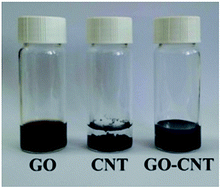Reduced graphene oxide–carbon nanotube (rGO–CNT) hybrids have been synthesized by electrodeposition of GO stabilized CNT using indium tin oxide (ITO) as working electrode, followed by electrochemical reduction of GO–CNT into rGO–CNT on the surface of ITO. The combined characterizations of scanning electron microscopy (SEM) and X-ray photoelectron spectroscopy (XPS) analyses have been used to examine the structure of rGO–CNT hybrids, indicating the successful preparation of hybrids. More importantly, compared with the bare ITO and rGO/ITO electrodes, the rGO–CNT/ITO electrode exhibits excellent sensing performance for electrochemical detection of ascorbic acid (AA), dopamine (DA) and uric acid (UA), leading to a high-performance electrochemical sensor for simultaneous detection of AA, DA and UA. The linear detection ranges of the AA, DA and UA sensors based on rGO–CNT hybrids were estimated to be 10–200 μM, 0.2–8.0 μM and 0.2–16.0 μM, and the detection limits were 5.31 μM, 0.04 μM and 0.17 μM, respectively.

